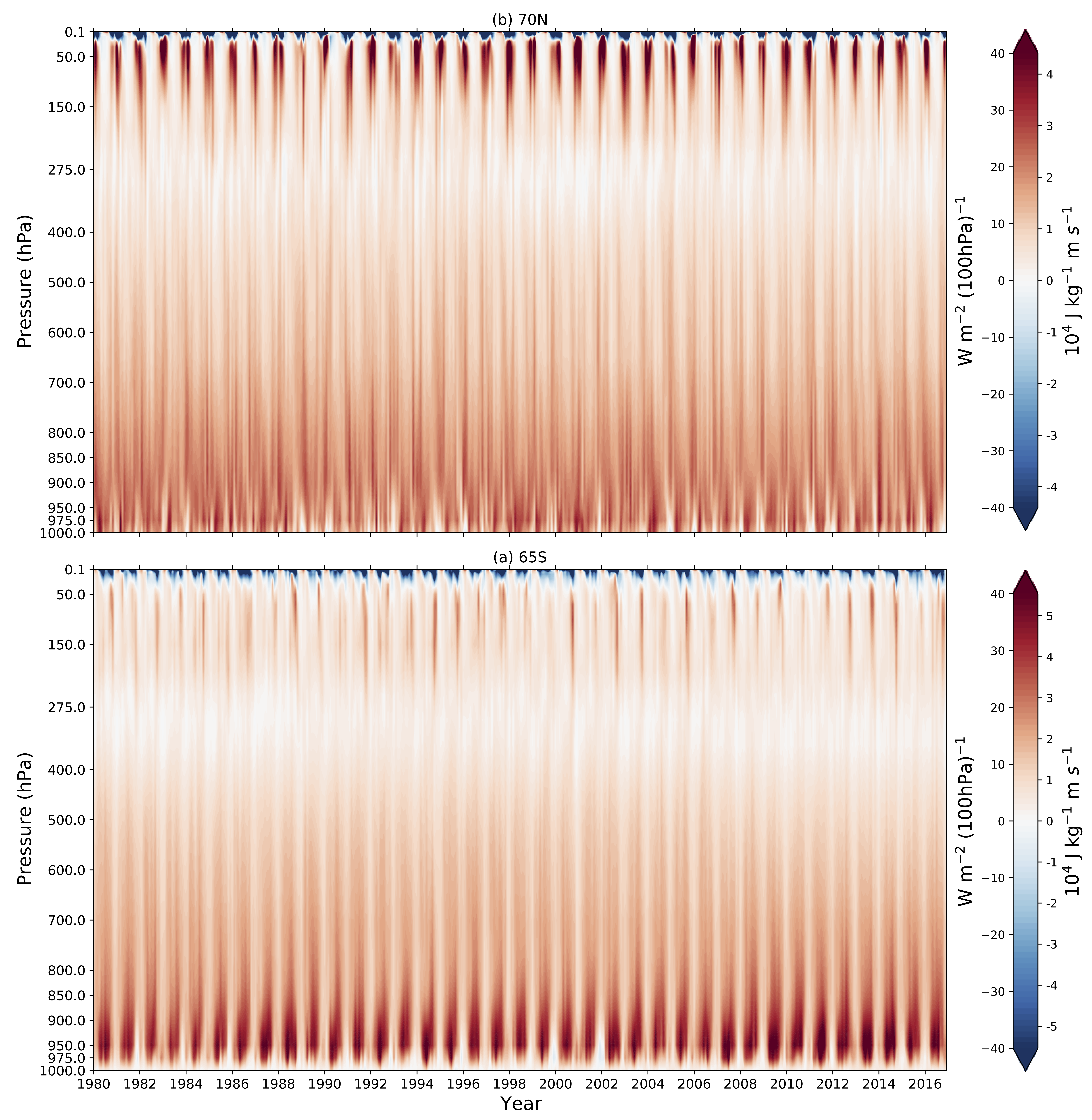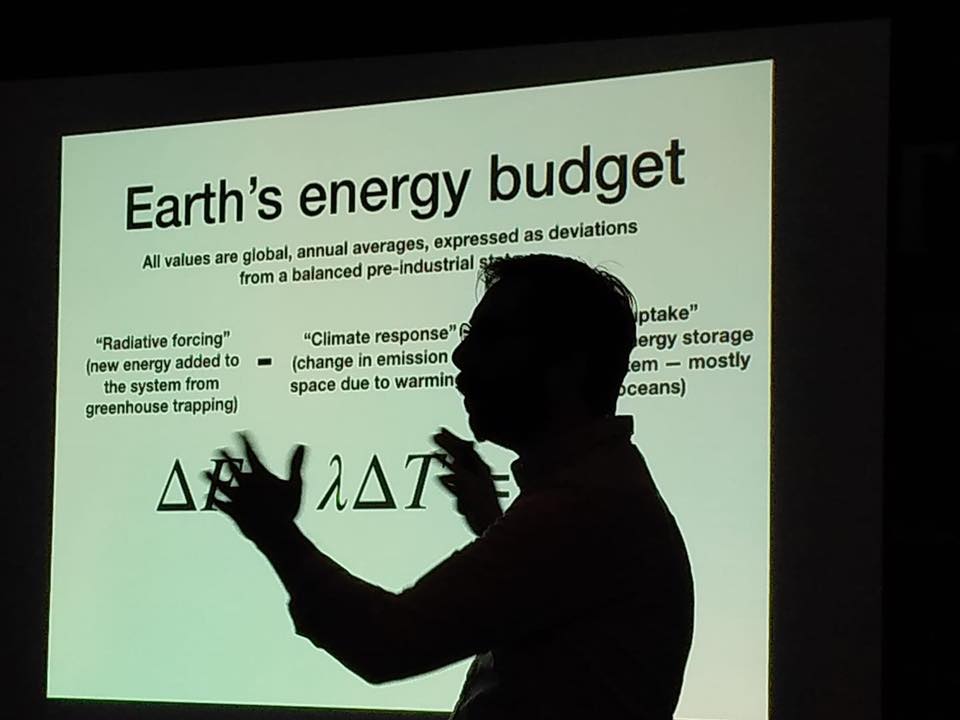Posts tagged news
New paper on vertical structure of poleward energy flux
- 22 February 2021
PhD student Chris Cardinale leads this new paper “Stratospheric and Tropospheric Flux Contributions to the Polar Cap Energy Budgets”, now accepted in Journal of Climate.
In this, Chris’s first peer-reviewed publication, we look at the detailed temporal and vertical structure of the poleward fluxes of moist static energy using the NASA-MERRA-2 reanalysis. We are interested in separating the effects of stratospheric and tropospheric circulations on the total poleward energy transport, as well as the differing impacts of these circulations on the energy budget of the polar regions.

Two new PhD positions available!
- 19 October 2020
I’m happy to announce that I will be recruiting two new graduate students for fully funded PhD positions in my group starting Fall 2021. Both projects are funded on new grants from the National Science Foundation, involve exciting opportunities for cutting edge science and interdisciplinary training, and will result in significant contributions back to the open-source scientific software community.
Details about both opportunities follow.
New website!
- 16 October 2020
Hello world! Welcome to the latest refresh of my website!
This Sphinx-based redesign was inspired by this blog post by Chris Holdgraf. Thanks Chris for all you do to keep the Python-based open-source community moving forward!
Brian Rose receives tenure at UAlbany
- 04 June 2019
Hello world, I got some good news today: promotion to Associate Professor with tenure.
Public talk about climate sensitivity
- 03 October 2018
Brian gave a science talk at a bar!
“Climate Sensitivity in an Uncertain World” occurred on the evening of October 2, 2018 at Slidin’ Dirty in Schenectady NY. This was a special Science on Tap event coinciding with the MiSci Science Festival.

Lance Rayborn appointed as Research Associate at PNNL
- 23 January 2018
Rose group alum Lance Rayborn (MS 2017) is now working as Research Associate at the Department of Energy’s Pacific Northwest National Laboratory (PNNL). He is working with Dr. Hui Wan, Dr. Balwinder Singh and Dr. Phil Rasch on atmospheric model development and evaluation of DoE’s E3SM (Energy Exascale Earth System Model) at PNNL. This will primarily consist of verifying/improving cloud and turbulence parameterizations as well as establishing efficient strategies for testing/analyzing the model.
Rose group @ AGU!
- 08 December 2017
Our climate dynamics group will be traveling in New Orleans next week to share some recent research and catch up with all our colleagues at the AGU Fall Meeting 2017!
Here are abstract numbers and links for all our contributions:
New paper by Rose, Cronin and Bitz on exoplanet ice cover at low and high obliquity
- 04 August 2017
Brian’s latest paper (with colleagues Tim Cronin from MIT and Cecilia Bitz from UW) is called “Ice Caps and Ice Belts: the effects of obliquity on ice-albedo feedback”. It has been accepted for publication in the Astrophysical Journal. The paper looks at the basic rules governing planetary ice extent on Earth-like exoplanets at different obliquities. Click here for a preprint of the accepted manuscript.
Obliquity is the angle of a planet’s axis of rotation relative to its orbital plane. On Earth that angle is about 23.5º, and among other things, is the reason we have seasons. Something funny happens for planets at obliquity angles exceeding 55º. When you average over a whole year, the total amount of sunlight is largest at the poles and smallest at the equator.
Cameron Rencurrel completes his MS thesis
- 16 February 2017
Cameron Rencurrel has successfully completed and defended his thesis for the MS (Master of Science) degree, and is the second graduate from our group! Cameron is staying to continue on to his PhD.
Cameron’s thesis is entitled Understanding Climatic Adjustments to Variations in Tropical Ocean Heat Transport. It is a follow-up study to Rose and Ferreira (2013, J. Climate). The tropical oceans take up vast amounts of energy through air-sea heat fluxes, especially in the equatorial regions dominated by wind-driven upwelling of cold water. Over long time periods, this tropical heat uptake is roughly balanced by heat release from the ocean to the atmosphere in other regions closer to the poles.
Lance Rayborn completes his MS thesis
- 01 December 2016
Lance Rayborn has successfully completed and defended his thesis for the MS (Master of Science) degree, and is the first graduate from our group!
Lance’s thesis is entitled Understanding the Dependence of Radiative Feedbacks and Clouds on the Spatial Structure of Ocean Heat Uptake. It is a follow-up study to Rose et al. (2014, GRL). Lance used a variety of analysis techniques including radiative kernels to carefully compare the response of several different climate models to specific imposed patterns of ocean heat uptake. In particular, the study aims to draw specific causal links between spatial patterns of heat uptake under transient global warming and cloud processes that shape the overall global climate sensitivity.
New paper by Rose and Rayborn on effects of ocean heat uptake
- 26 August 2016
The latest paper from our group has been accepted for publication in Current Climate Change Reports. We wrote this piece at the invitation of the section editor Mark Zelinka.
The paper is Rose and Rayborn, “The effects of ocean heat uptake on transient climate sensitivity”. It deals with the phenomenon of time-dependent climate sensitivity, and explores some compelling new ideas about connections between the oceans, atmospheric radiation, and global cloud cover that determine climate sensitivity. Our paper includes substantial review as well as some interesting original results and speculations.
Snowball Earth synthesis submitted to Science Advances
- 04 May 2016
Brian contributed to a new synthesis article on the geology and climate dynamics of Snowball Earth, just submitted to Science Advances.
The lead author is Paul F. Hoffman, the geologist who has been the leading champion of the Neoproterozoic Snowball Earth hypothesis. Dr. Hoffman has long advocated for the importance of forward modeling studies of the physical and chemical environment of a Snowball Earth event, to bring context and constraints to the interpretation of the geological record. Along the way, he has cultivated relationships with some of the best climate dynamicists and modelers in the business. This review article summarizes recent progress on understanding the most profound episodes of global environmental change in Earth history.
Cameron Rencurrel and Lance Rayborn awarded summer research fellowships
- 20 April 2016
Two of our graduate students have been awarded funded fellowships to attend computational research workshops in Summer 2016.
Cameron Rencurrel will travel to NCAR in Boulder Colorado to attend the Dynamical Core Model Intercomparion Project (DCMIP) Summer School on Future-Generation Non-Hydrostatic Weather and Climate Models. This will include two weeks of lectures and workshops on the theory, design and development of next-generation numerical models for atmospheric simulation. Sponsors include NCAR, NOAA, NASA, NSF, DOE, and the WMO.
Water vapor paper posted online
- 23 March 2016
Our latest paper: The vertical structure of tropospheric water vapor: comparing radiative and ocean-driven climate changes, by Rose and Rencurrel, is in press for Journal of Climate. See previous post for a description. The preprint is now available online from my publication page, or directly from Journal of Climate.
Water vapor paper accepted in J. Climate
- 14 March 2016
Our latest paper: The vertical structure of tropospheric water vapor: comparing radiative and ocean-driven climate changes, by Rose and Rencurrel, is now accepted for publication in Journal of Climate.
The paper looks at rates of change of precipitable water with surface temperature in a suite of simulations driven by different combinations of greenhouse gas forcing and prescribed ocean heat uptake. We find fractional rates ranging between 3.6 and 11 %/K globally. These results seem at first glance to suggest substantial departures from Clausius-Clapeyron scaling, but actually result from different spatial patterns of temperature change and nearly fixed relative humidity.
Our group goes to AGU!
- 11 December 2015
Our climate dynamics group will shortly be traveling to San Francisco to share some recent research and catch up with all our colleagues at the AGU Fall Meeting 2015!
Here are abstract numbers and links for all our contributions:
Brian Rose receives NSF Career grant
- 19 August 2015
I am very pleased to announce that I have received a 5-year grant from the National Science Foundation under their Faculty Early Career Development Program (CAREER).
The grant is entitled CAREER: Understanding the role of oceans in the planetary energy budget. It will provide critical support for our group’s work studying the connections ocean heat uptake and transport and atmospheric processes (dynamical, radiative, hydrological) controlling the top-of-atmosphere radiation balance.
New paper submitted
- 17 July 2015
New paper submitted to Journal of Climate: The vertical structure of tropospheric water vapor: comparing radiative and ocean-driven climate changes, by Rose and Rencurrel.
Welcome Lance Rayborn
- 14 May 2015
Graduate student Lance Rayborn has joined our group. Lance will be working on understanding links between ocean heat uptake and cloud feedback under global warming scenarios.
First public release of climlab
- 25 February 2015
I am very pleased to announce the first public release of climlab: a Python-based toolkit for process-oriented climate modeling. See code page for more details.
Public lecture at MCLA
- 29 January 2015
I gave an invited public lecture on the fundamental science of climate change at the Massachusetts College of Liberal Arts: “What Sets the Temperature of the Earth?”. This was part of MCLA’s Green Living Seminar Series. A podcast of my talk is available here.
Waterbelts paper accepted
- 23 January 2015
“Waterbelts” paper accepted for publication in JGR. And here it is.
Waterbelts paper submitted
- 01 October 2014
New paper submitted to JGR: Stable “Waterbelt” climates controlled by tropical ocean heat transport: a non-linear coupled climate mechanism of relevance to Snowball Earth
Welcome Cameron Rencurrel
- 26 August 2014
Welcome to my new graduate student Cameron Rencurrel, who comes to U. Albany from Texas A&M. He can be found in ES 346.
Heat uptake paper featured on Oceans@MIT
- 20 March 2014
Oceans@MIT news feature about my work on the climate response to ocean heat uptake, and related work by MIT researchers on the dynamics of ocean heat uptake.
PhD positions available
- 05 December 2013
Positions are available for new Ph.D. students in my research group, staring Fall 2014. Please email me for details!
Heat uptake paper submitted
- 05 December 2013
New paper just submitted to GRL: The dependence of transient climate sensitivity and radiative feedbacks on the spatial pattern of ocean heat uptake, by Rose, Armour, Battisti, Feldl and Koll.
Oceans@MIT spotlight on new faculty
- 09 September 2013
Oceans@MIT story about graduates of the MIT PAOC program in new faculty positions (including yours truly).
MIT News feature on my ocean heat transport / weak temperature gradient paper
- 20 March 2013
MIT News article about my recent Journal of Climate paper on ocean heat transport and weak temperature gradients.